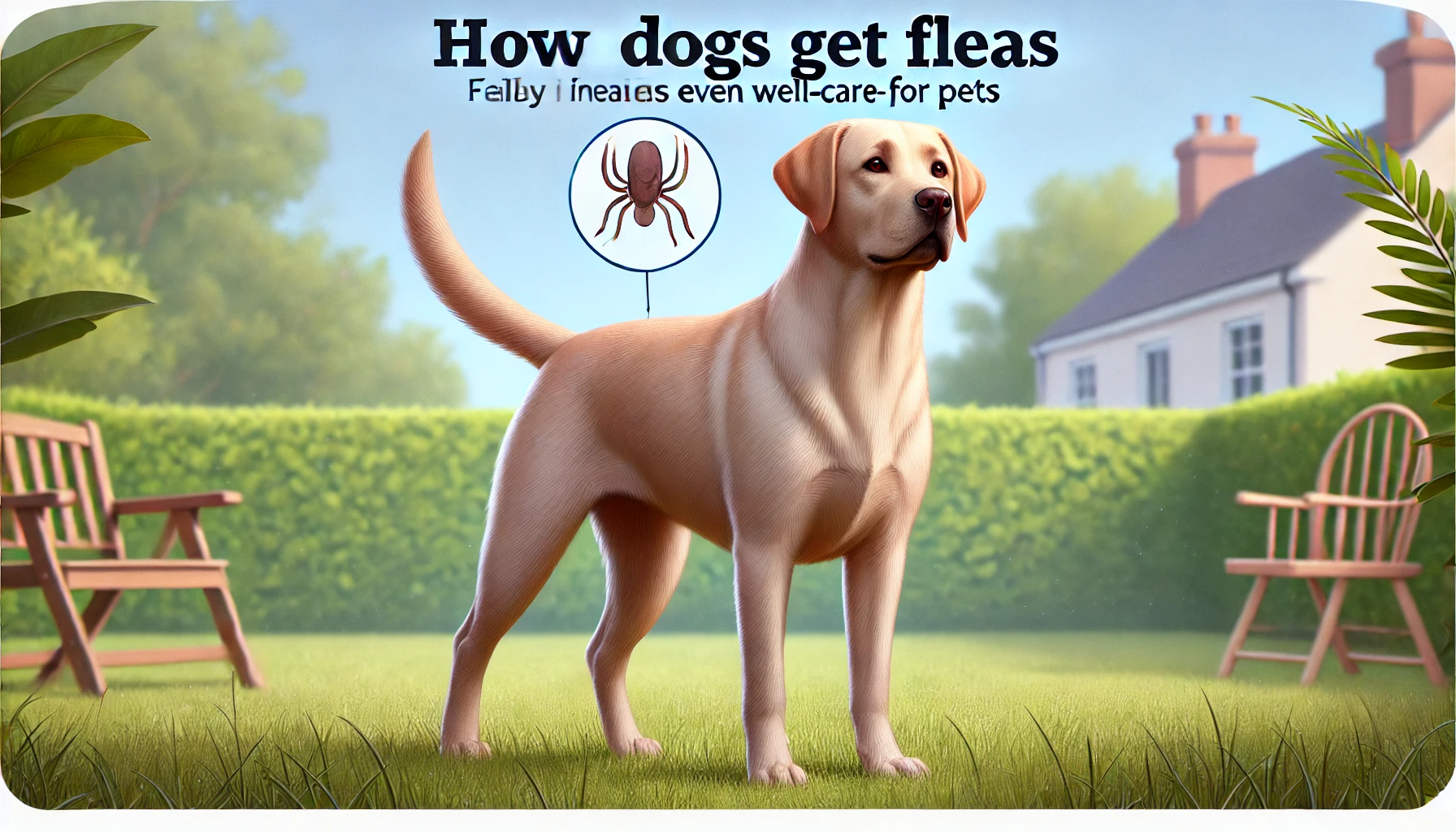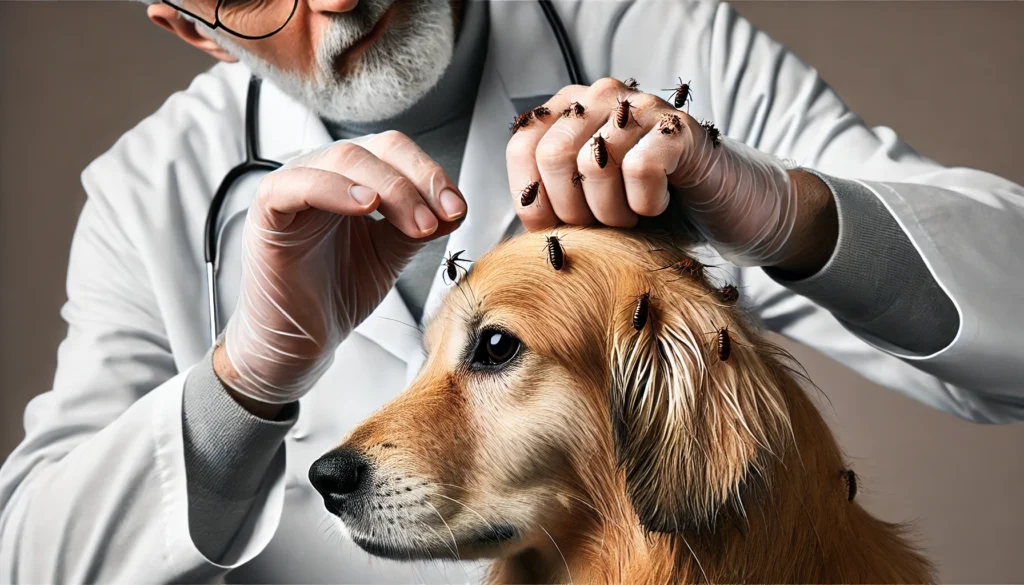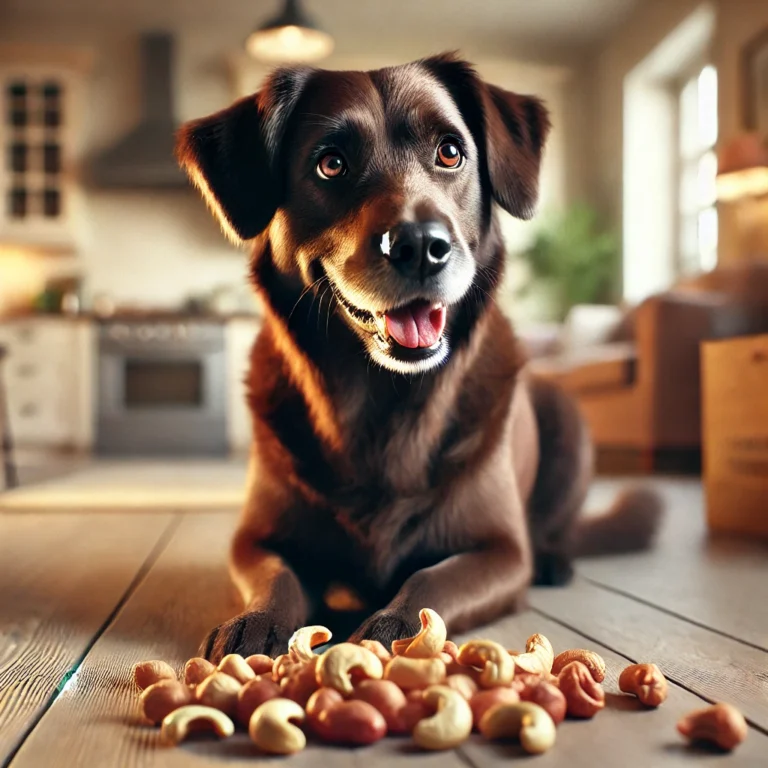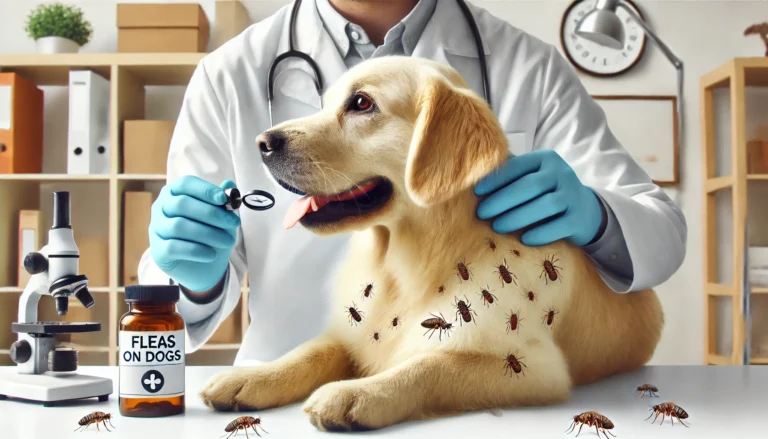How Dogs Get Fleas: Stop Annoying Infestations Now!

Fleas are a common and frustrating problem for dog owners. These tiny, blood-sucking pests can cause severe itching, skin infections, and even transmit diseases. Understanding how dogs get fleas, the life cycle of fleas, and how they spread is key to preventing and managing flea infestations. This article will explore various ways dogs get fleas, the flea life cycle, and provide guidance on how to protect your dog from these pesky parasites.
1. How Do Dogs Get Fleas?
Dogs get fleas in many ways, and understanding how dogs get fleas is crucial to preventing infestations. Below are some of the primary methods:
1.1. Direct Contact with Infected Animals
Fleas are highly mobile and can easily jump from one host to another. If your dog comes into contact with another dog, cat, or animal that is infested with fleas, it’s likely that your dog will pick them up as well. Fleas are especially common in areas where animals gather, such as parks, grooming salons, and kennels. Even wild animals like squirrels and raccoons can carry fleas, and your dog may get fleas while roaming in your backyard.
1.2. Fleas in the Environment
Even if your dog isn’t directly interacting with other animals, fleas can still infest your pet through your home and yard. Fleas can live in carpets, rugs, furniture, and bedding, especially if pets have previously been in these areas. Outdoor areas, such as your backyard, can also harbor fleas, particularly in shaded, damp spots. Fleas lay their eggs on dogs, but the eggs often fall off into the environment, where they hatch into larvae and pupae, continuing the infestation cycle. This is one of the most common ways that dogs get fleas, even if they don’t interact with other pets.
1.3. Lack of Flea Protection
If your dog is not receiving proper flea prevention treatments, they are more vulnerable to flea infestations. Flea preventatives like oral tablets, topical medications, and flea collars can effectively protect your dog from fleas. Without these treatments, your dog is much more likely to get fleas from their environment or other animals. Flea prevention is essential in ensuring your dog remains protected from fleas.
1.4. Winter Fleas
Though fleas are more active in warmer weather, dogs can still get fleas in the winter. Fleas can survive in heated indoor environments, and if a dog enters a home or area with fleas, they can bring them back into your house. Fleas reproduce in warmer conditions, and a single flea can lay dozens of eggs, leading to an infestation. Understanding how dogs get fleas in winter can help ensure that you continue using flea treatments throughout the colder months.

2. Flea Life Cycle and Reproduction
To understand how dogs get fleas and how they spread, it’s crucial to know the flea life cycle. Fleas have a four-stage life cycle: egg, larva, pupa, and adult.
2.1. Flea Eggs
Fleas begin their life cycle as eggs. Female fleas lay their eggs on the dog’s skin, but the eggs typically fall off into the environment, such as your home’s carpeting or bedding. These eggs hatch into larvae after about 1 to 10 days, depending on environmental conditions. Flea eggs are white and round, about 0.5 mm in size, and often difficult to see. If you suspect flea eggs on your dog, they will likely be found in areas like the neck, tail, and back.
2.2. Flea Larvae
Once flea eggs hatch, they develop into larvae, which are small, worm-like creatures. Larvae avoid light and prefer to live in dark, hidden places such as carpet fibers, cracks in wooden floors, or bedding. Flea larvae feed on organic matter, including adult flea feces (which contain undigested blood). This stage typically lasts 5 to 20 days before the larvae move to the next stage of development. Understanding how the larvae grow and develop helps in knowing where fleas hide in your home.
2.3. Flea Pupae
Flea larvae spin themselves into a cocoon to become pupae, the next stage in the flea life cycle. Pupae can remain dormant for weeks or months, depending on environmental conditions. Fleas in the pupal stage are resistant to many treatments and can survive in your home for an extended period. Pupae will only hatch into adult fleas when they sense a suitable host, typically a dog or cat. This stage is crucial in understanding how dogs get fleas, as it can lead to delayed infestations.
2.4. Adult Fleas
Once an adult flea emerges from its cocoon, it will seek a host to feed on. Adult fleas are about 1-2 mm long and have strong hind legs that allow them to jump onto a dog or other host. Fleas can live for several weeks on a dog, feeding on its blood and reproducing. A single female flea can lay up to 50 eggs per day, which perpetuates the cycle. The lifespan of an adult flea is typically around 2 to 3 months.
3. Can Humans Get Fleas from Dogs?
Yes, humans can get fleas from dogs, though it is not common. Fleas prefer to stay on their primary host, such as a dog or cat. However, if your dog is infested with fleas, the fleas can jump onto humans, especially if humans have close contact with the dog. Fleas can attach to clothing, skin, or hair temporarily, and they might bite humans, leading to itching or irritation. Fleas don’t typically live on humans for long, as they need blood from a host like a dog to survive. Understanding how humans can get fleas from dogs is important in managing flea infestations.
3.1. Can Dog Fleas Live on Humans?
Fleas that infest dogs are generally called Ctenocephalides canis, or dog fleas. These fleas can bite humans but prefer to stay on their primary host (the dog). While dog fleas can temporarily live on humans, they are not suited for long-term survival on human skin and will generally move back to the dog. This is another reason why it’s essential to treat your dog for fleas to prevent them from affecting humans.
3.2. Can Fleas Travel on Humans?
Fleas can hitch a ride on humans to different locations, but they won’t thrive on human skin. When fleas transfer from a dog to a human, they may temporarily live on the person’s clothes, but without a pet to feed on, the flea will soon die. This is why flea infestations can spread across households, especially when a pet infested with fleas is brought into a home and comes into contact with humans or other pets.
4. Where Do Fleas Live and Hide?
Fleas are not limited to the dog’s body and can be found in various places around the home and environment. Here’s where fleas typically live:
- On Dogs: Fleas hide in the fur and skin of dogs, typically in areas with dense hair, such as the neck, tail base, and under the legs.
- In Homes: Fleas can live in the carpets, furniture, and bedding inside your home. The warm, humid environment of your house, particularly areas like pet bedding, is perfect for fleas to thrive.
- In Yards: Fleas are commonly found in the grass and soil of your yard. If your dog spends time outside, they may pick up fleas from these areas, especially if the grass is tall or damp.
4.1. Can Fleas Live on Clothes?
Fleas can temporarily live on clothing but do not prefer humans as hosts. Fleas are more likely to stay on pets, where they can feed regularly. However, if a flea jumps onto a person’s clothing from an infested dog, it may stay there for a while. Washing clothes and using a hot dryer can help kill any fleas that may be on them.
5. How Fast Do Fleas Reproduce?
Fleas reproduce very quickly. After mating, female fleas can begin laying eggs within 24-48 hours. Each female can lay up to 50 eggs per day, which quickly leads to an infestation if left untreated. Fleas go through four stages of development in their life cycle, and the entire cycle—from egg to adult—can be completed in as little as two weeks under optimal conditions. This rapid reproduction is one of the reasons dogs get fleas so easily and why infestations can escalate quickly.
6. Flea Prevention: How to Protect Your Dog from Fleas
To understand how dogs get flea Preventing fleas from infesting your dog is the most effective way to keep both your pet and home free from the discomfort and health risks fleas can bring. Understanding how dogs get fleas is essential to choosing the right preventive measures. There are several methods available to protect your dog from fleas, and using a combination of these approaches can offer the best results. Below, we’ll explore these prevention methods in more detail to help reduce the chances of dogs get fleas.
Topical Flea Treatments
Topical flea treatments are one of the most popular and effective ways to prevent fleas on dogs. These treatments are applied directly to your dog’s skin, often between the shoulder blades or at the back of the neck, where they can’t lick them off. Once applied, the treatment spreads through the dog’s skin and bloodstream, killing fleas on contact and preventing future infestations. This method is especially effective in preventing how dogs get fleas from other animals. Topical treatments are typically effective for a month, and some brands offer longer-lasting protection, making them an essential part of your flea control routine.
Oral Flea Medications
Oral flea medications are pills or chewables that your dog ingests. Once ingested, the medication enters your dog’s bloodstream, and when fleas bite your dog, they ingest the treated blood, causing them to die. If you’re wondering how dogs get fleas, it’s often through direct contact with infested animals, and these oral medications are one of the best ways to prevent and treat flea infestations. Oral flea medications provide up to a month of protection, and some kill fleas quickly, preventing them from multiplying. If your dog suffers from fleas, oral treatments are a great alternative to topical treatments.
Flea Collars
Flea collars are another great option for long-term flea prevention. These collars release chemicals that repel or kill fleas over time, providing continuous protection. When wondering how dogs get fleas, it’s important to remember that fleas thrive in environments like parks or even backyards. Flea collars work by releasing chemicals that spread across your dog’s body, killing any fleas that attempt to infest your pet. Flea collars provide long-lasting protection, offering up to 8 months of defense against fleas. This is particularly helpful in preventing dogs from getting fleas in areas where they may encounter other animals with fleas.
Regular Grooming
Grooming your dog regularly plays a crucial role in preventing fleas. Bathing your dog with flea shampoo removes fleas and their eggs, while brushing helps you catch any flea dirt or fleas that may be hidden in your dog’s fur. Regular grooming helps you keep an eye on how dogs get fleas by checking for signs of flea activity on your pet’s body. By grooming your dog frequently, you not only remove fleas but also help prevent future infestations. While grooming does help with removing fleas, it should be paired with other flea treatments for the best results in keeping your dog flea-free.
Environmental Control
Fleas don’t just live on dogs; they can also infest your home and yard. This is why it’s important to control the environment where your dog spends time. Fleas can lay eggs on your dog, and these eggs often fall off into your home or yard, leading to an infestation. To stop fleas from being a recurring problem, vacuum your home regularly to remove flea eggs, larvae, and pupae. Wash your dog’s bedding and toys, and treat your yard with flea control products to ensure that fleas aren’t lurking outside. Understanding how dogs get fleas in the environment helps you keep the space around them free of these pesky parasites.
Combining Prevention Methods
For the most effective flea control, it’s often best to combine several of these methods. For example, using a flea collar alongside topical treatments or oral medications will provide comprehensive protection against fleas. Regular grooming and environmental control (such as cleaning your home and yard) will complement these treatments and help eliminate fleas and their eggs from your dog’s surroundings. By using a combination of flea prevention methods, you can stop the cycle of how dogs get fleas and keep your dog healthy and comfortable year-round.
Do You Know
Geckos are insectivores, meaning their diet primarily consists of insects. Offer a variety of gut-loaded insects such as crickets, mealworms, waxworms, and dubia roaches. Feed appropriately sized prey items, with juveniles requiring smaller insects more frequently than adults. Dust insects with calcium and vitamin D3 supplements every other feeding, and provide a multivitamin supplement once a week.
Conclusion
Understanding how dogs get fleas and the flea life cycle is essential for preventing and managing flea infestations. Fleas can be contracted from other animals, the environment, and even through lack of protection. By using flea treatments and maintaining a clean environment, you can protect your dog from fleas and the discomfort they cause. If you do notice fleas, act quickly to break the cycle and prevent further issues. Regular flea prevention will ensure your dog remains healthy and flea-free, no matter the season.
What causes dogs to get fleas?
Dogs get fleas primarily from contact with other animals that are already infested or from environments where fleas are present. When dogs encounter other pets, wildlife, or areas with fleas, the parasites jump onto their fur and start feeding on their blood. Fleas thrive in warm, humid conditions, so areas like parks, yards, and homes with poor cleaning habits can be breeding grounds for fleas. The most common cause of fleas in dogs is direct exposure to other flea-infested animals or environments.
How do dogs get fleas in the first place?
Dogs get fleas when they come into direct contact with flea-infested animals, like other dogs, cats, or wildlife. Fleas jump from one host to another, attaching themselves to a dog’s fur when they get close. Dogs can also pick up fleas from outdoor areas such as grass, wooded spaces, or public dog parks. Fleas lay eggs on the host, which fall into the environment, allowing the cycle to continue. If a dog is not protected by flea treatments, they are more likely to get fleas.
Can dogs catch fleas from grass?
Yes, dogs can get fleas from grass, especially in areas where fleas are common. Fleas live in the environment as eggs, larvae, and pupae, often hidden in grass and vegetation. When a dog walks or plays in these areas, fleas can jump onto their fur. This is a common way dogs get fleas, as fleas prefer to wait in tall grasses, under bushes, and in other cool, shady areas. Keeping your yard maintained can help reduce the likelihood of fleas infesting your dog.
What is the most common way dogs get fleas?
The most common way dogs get fleas is through direct contact with other animals that are infested with fleas. This includes interactions with other pets at parks, dog boarding facilities, or homes where fleas are present. Wild animals, such as squirrels or raccoons, can also carry fleas that may jump onto your dog if they encounter them. Additionally, flea eggs from infested environments can hatch and jump onto your dog. Regular flea treatments can help protect your dog from these common sources.
Can fleas live in human hair?
While fleas can bite humans, they do not thrive in human hair. Fleas prefer to live on furry animals, such as dogs, because they need a warm and dense fur environment to remain comfortable and reproduce. Humans don’t provide the same type of habitat, but fleas can temporarily live in human hair if they jump onto a person from an infested dog. Dogs Get Fleas However, they won’t stay long on humans and will likely move back to the dog where they can feed on blood.
Are fleas harmful to dogs?
Yes, fleas can be very harmful to dogs. They cause intense itching and irritation, leading to excessive scratching that can result in open sores and infections. In some cases, fleas can transmit tapeworms or other diseases to dogs. Dogs Get Fleas can also lead to a condition called flea allergy dermatitis, which makes the dog highly sensitive to flea saliva, causing severe allergic reactions. If left untreated, fleas can weaken a dog’s immune system, leading to more serious health problems.
How to get rid of fleas in a dog?
To get rid of fleas in a dog, the first step is to treat the dog with a flea medication. This could be topical treatments, oral medications, or flea collars that kill fleas on contact or prevent them from reproducing. Regular grooming, including bathing your dog with flea shampoo, can help remove fleas and their eggs. It’s also essential to treat the environment by vacuuming the home, washing bedding, and using environmental flea sprays. Consistent flea treatments for your dog are key to preventing future infestations.
Do dog fleas bite humans?
Yes, dog fleas can bite humans, although they prefer to stay on dogs. Fleas are bloodsuckers, and they will bite humans if given the opportunity. They tend to bite humans around the ankles, legs, or waist area, where they can reach exposed skin. While dog fleas can temporarily latch onto a human, they don’t thrive on human skin and will typically return to the dog for feeding. Fleas on humans can cause itching and irritation, but they are unlikely to remain there for long.
How do I protect my dog from fleas?
To protect your dog from fleas, it’s important to use regular flea prevention treatments, such as topical treatments, flea collars, or oral medications. These products will kill fleas and prevent them from infesting your dog. Regularly grooming and bathing your dog can help remove fleas that may be on the skin. Keeping your home clean, vacuuming often, and treating your yard can also help prevent fleas from getting to your dog in the first place. Consistency in flea prevention is key to keeping your dog safe.
Are fleas harmful to humans?
Fleas can be harmful to humans in several ways. While they don’t live on human skin, they can bite humans, causing itching, redness, and discomfort. Fleas can also transmit diseases, such as flea-borne typhus and plague, though these are rare. Additionally, fleas can carry tapeworms, and humans may accidentally ingest flea eggs or larvae if they have close contact with an infested dog. Taking steps to protect both your pets and yourself from fleas is important for avoiding these potential health risks.
Is it OK to touch a dog with fleas?
While it’s generally safe to touch a dog with fleas, it’s important to wash your hands afterward to prevent any flea eggs or larvae from spreading to other areas. Fleas can transfer to humans temporarily, causing bites or discomfort, but they won’t live on human skin for long. If your dog has fleas, it’s best to treat the dog and clean the environment to reduce the risk of fleas spreading. Regular flea treatments will also help prevent re-infestation, keeping your dog and home flea-free.
Does bathing a dog get rid of fleas?
Bathing a dog can help remove fleas temporarily, but it’s not a long-term solution for flea control. Flea shampoos can kill fleas on contact, but they don’t address the larger infestation of fleas and their eggs. While bathing your dog is important to remove visible fleas, it’s best combined with other treatments like flea medications and environmental cleaning to fully eliminate fleas. Bathing your dog regularly can help reduce the number of fleas, but consistent flea prevention is key to long-term control.
Why do fleas jump so fast?
Fleas jump so fast because they have specialized hind legs that are incredibly strong and efficient at propelling them long distances. A flea’s legs can push them up to 150 times their body length in a single leap, making them capable of jumping onto a dog or other animal quickly. This rapid jumping ability allows fleas to easily move from one host to another, which is how dogs get fleas in the first place. Fleas are designed to be highly mobile to ensure they can find a host to feed on.
Do fleas crawl on humans?
Fleas can temporarily crawl on humans, especially if they jump onto them from an infested dog. However, fleas do not thrive on human skin because it lacks the dense fur that fleas prefer for feeding and reproduction. While fleas may crawl on you briefly, they typically move quickly back to their primary host, the dog. The focus should be on treating the dog and the environment to prevent fleas from jumping onto humans in the first place. Fleas on humans are not common, but they can still cause discomfort.
How long do fleas live?
The lifespan of fleas depends on their access to a host and the environment. On a dog, fleas can live anywhere from two weeks to several months. Female fleas, in particular, can live up to 100 days if they can consistently feed on the dog’s blood. Fleas that are not on a host may only survive a few days to a week without feeding. If fleas get onto a dog, they begin reproducing quickly, which is why it’s important to control the flea infestation as soon as you notice that your dog has fleas.
How to stop fleas jumping on you?
To stop fleas from jumping on you, it’s essential to address the root cause: treating the dog for fleas. Fleas usually jump onto humans from an infested dog, so the most effective way to prevent this is by using flea prevention methods on your dog, such as topical treatments, oral medications, or flea collars. Additionally, vacuuming your home regularly and washing your dog’s bedding can help remove any flea eggs or larvae, reducing the chances of fleas jumping onto you. Maintaining a flea-free environment will stop fleas from jumping onto you or your dog.






